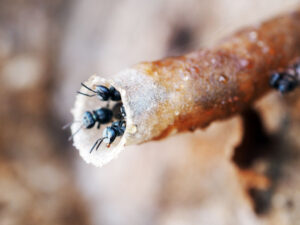The late Mzee David Charo Ngala's love affair with Arabuko-Sokoke Forest started in 1970 when he landed a casual job at the Gede Forest Station. A year later, Ngala was recruited by the then Forest Department (FD) as a nursery attendant. From then on, Ngala moved to different positions within the FD in Arabuko-Sokoke Forest, from nursery attendant to stores attendant and finally to driver. As a driver, he had the opportunity to venture into the forest and its various stations.
Ngala's knowledge of Arabuko-Sokoke grew with time, cementing his fondness for the forest. In 1983, he started guiding researchers into the Arabuko-Sokoke Forest, as he was, at that time, the only person knowledgeable about it. These research expeditions exposed him to the scientific aspects of the forest. Ngala's interest in the birds, insects, reptiles, mammals and trees of Arabuko-Sokoke Forest kindled his appreciation of its biodiversity value. A key species he specialized in was the Sokoke Scops Owl.
Ngala guided many researchers in their studies of the Sokoke Scops Owl, including Munir Virani, who later became a raptor specialist. Other researchers he worked with were Leon Bennun, John Fanshawe, Paul Matiku (currently Executive Director of Nature Kenya) and Colin Jackson. The number of researchers and bird watchers visiting the forest grew following each round of research work and publications, attracting younger community members mentored by Ngala to join in and assist. They included Willy Kombe in 1992 and Jonathan Baya, Emmanuel Thoya and Bakari George in 1994. Others joined later including Albert Baya and Jonathan Mwachongo. These individuals developed into research assistants and bird guides of Arabuko-Sokoke Forest. These young guides would later undergo professional training and establish and register the Arabuko Sokoke Forest Guides Association in 1996.
In 1995, Arabuko-Sokoke Forest faced the threat of excision by the government around Roka and Mpendala areas. Ngala responded to the threat by mobilizing communities to oppose the move. This action led to the formation of Arabuko-Sokoke Forest Adjacent Dwellers Association (ASFADA). Community opposition to annexing the forest bore fruit, with ASFADA prevailing as a forest conservation lobby group.
ASFADA was instrumental in piloting Participatory Forest Management (PFM) from 1997 to 2002 in Dida, west of Arabuko-Sokoke Forest, Ngala’s birthplace. The PFM pilot process culminated in the drafting of the Forests Act (2005), which formed the legal foundation for community participation in the management of forests in Kenya. Ngala contributed immensely to this process that led to the current forest conservation and management system.
Ngala worked for the government in Arabuko-Sokoke Forest for 37 years, retiring in 2007. His love and commitment to the forest transcended beyond his formal employment. With support from friends, Ngala continued working as a guide, research assistant and a community mobilizer in Arabuko-Sokoke.
On several occasions, Ngala would camp at different locations in the forest, armed with a pair of binoculars, GPS, notebook and data sheets to gather information on happenings around the forest. Year in, year out, he would walk hundreds of kilometres in the forest each year to remove snares, record cut stems and observe tens of biodiversity parameters.
Ngala once said to me: “When I die in the forest, don’t look for me.” This statement best summarises his resolve to remain in Arabuko-Sokoke Forest his entire life. At that time it sounded awkward to me, but that was the real Ngala. He gave 52 years of his 70 years of life to the forest.
Though his age had advanced, he never showed signs of slowing down. Until his untimely demise through a motorcycle accident on 7th June 2022, Ngala was able to do three 1km transects in a day which is herculean task to younger people. His illustrious life, exploits and commitment to the conservation of Arabuko-Sokoke Forest will remain unparalleled for a long time.
Fare thee well, Mzee Ngala.
Tribute by Francis Kagema

